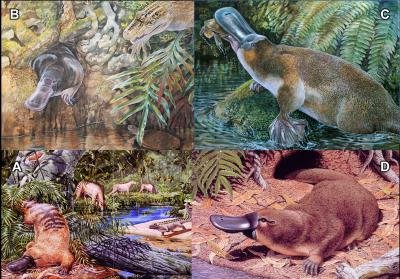
The platypus, native to Australia, is not just a random blend of features; it’s a unique member of the monotreme family, which are egg-laying mammals. Yes, you heard that right! The platypus lays eggs, which differentiates it from most mammals. Let’s embark on a journey through time to uncover the evolutionary history of this remarkable creature.
The Origins of the Platypus
The platypus traces its roots back to the early Cretaceous period, around 145 to 66 million years ago. Its ancestors were part of a group of mammals known as monotremes, which diverged from other mammals long before the rise of placental and marsupial mammals. Imagine these early mammals as pioneers, adapting to life in a world where dinosaurs roamed, and the climate was much different than today.
These early monotremes were small and likely resembled modern-day shrews. Though much of their behavior and physiology remains a mystery, they laid the groundwork for the unique adaptations we see in the platypus today. It’s like the platypus inherited a toolkit filled with traits from its distant ancestors, allowing it to thrive in various environments.
When the dinosaurs went extinct, the world began to change drastically. New niches opened up, and mammals had the chance to diversify. The monotremes, including the platypus, were able to hold onto their unique characteristics while other groups were evolving in different ways. This ability to adapt to their environment is part of what makes the platypus so special.
Distinctive Features of the Platypus
You might be wondering what exactly makes the platypus so unique. Let’s break down some of its most distinctive features. First and foremost, the bill of the platypus is perhaps its most recognizable trait. It’s soft, flat, and packed with sensitive receptors that allow the platypus to detect electrical signals from prey in the water. This adaptation is not found in many other mammals—it’s like having a built-in radar!
Next, we have the webbed feet. These are perfect for swimming, allowing the platypus to navigate through rivers and streams with ease. Once they’re on land, the webbing retracts to reveal sharp claws, which help them dig burrows. It’s almost like they’ve got a multi-tool for life in both water and land.
Let’s not forget that the platypus is one of the few venomous mammals. Males have spurs on their hind legs that can deliver a painful sting. This venom serves a purpose during mating season, likely to assert dominance over rivals. So, while it may look adorable, the platypus is not all cuddly!
The Role of the Platypus in Its Ecosystem
The platypus plays a crucial role in its ecosystem. As a semi-aquatic animal, it helps regulate populations of small invertebrates and crustaceans in rivers and streams. By hunting for food—like insects and larvae—they help maintain a balance in the aquatic food chain.
You might think of the platypus as an indicator species. This means that their health reflects the overall health of their environment. If platypus populations start to decline, it can signify problems in their habitat, such as pollution or habitat destruction.
For this reason, understanding the evolutionary history of the platypus is essential not only for appreciating its uniqueness but also for preserving its role in the ecosystem. It’s a reminder that our environment is a delicate web, where every strand, including the platypus, has significance.
The Evolutionary Significance of Monotremes
Monotremes, including the platypus and echidna, are a fascinating branch of mammalian evolution. They give us insight into what early mammals looked like and how they adapted over time. It’s as if they’re a living link to our planet’s distant past, helping scientists understand the changes that have occurred in mammalian evolution.
Studying monotremes can also shine a light on the different reproductive strategies in mammals. While most mammals give live birth, the ability of monotremes to lay eggs is a reminder of the diversity found within the animal kingdom. It highlights how different evolutionary paths can lead to unique adaptations suited for survival.
Moreover, understanding the evolutionary history of the platypus allows researchers to explore questions about mammalian development and physiology. This is crucial for fields like conservation biology, genetics, and ecology.
Future Challenges for the Platypus
Despite their remarkable evolutionary journey, platypuses face several challenges today. Habitat loss due to urban development, agriculture, and pollution threatens their natural environment. Climate change also poses risks, altering the rivers and streams they depend on for food and nesting.
It’s essential to raise awareness about these issues. Conservation efforts aimed at protecting platypus habitats can help ensure these unique creatures continue to thrive. Every little effort counts, whether it’s restoring riverbanks or supporting conservation programs.
As we learn more about the platypus, it becomes clear that protecting its habitat is vital not only for the species but also for the overall health of our ecosystems. These adorable mammals are worth preserving, not just for their quirky looks, but for the important roles they play in nature.
The evolutionary history of the platypus is a testament to the wonders of nature and adaptation. From their unique egg-laying abilities to their role in the ecosystem, platypuses are far from ordinary. They remind us of the rich tapestry of life that has evolved on our planet, illustrating how different species can thrive in their unique niches.
As we move forward, let’s appreciate and protect these remarkable creatures. After all, the world needs its quirks—like the charming platypus—more than ever. By understanding their place in the evolutionary timeline, we not only learn about the past but also about the future of our planet and all its inhabitants.
